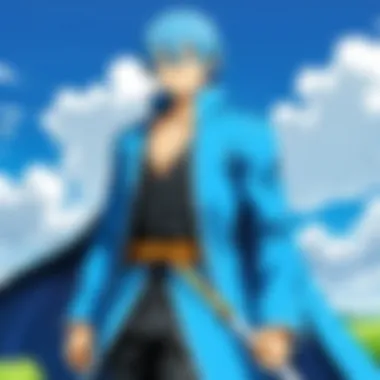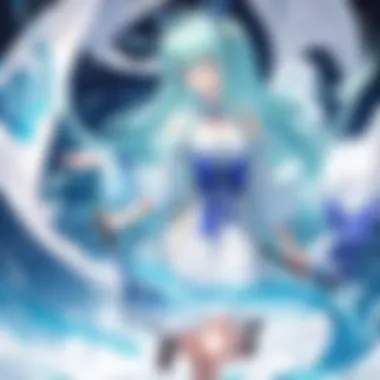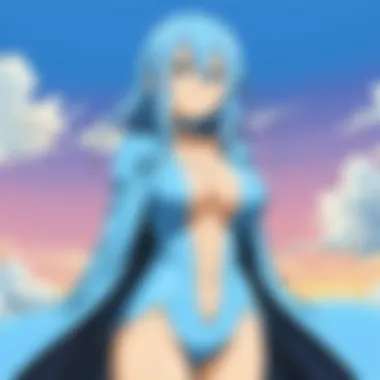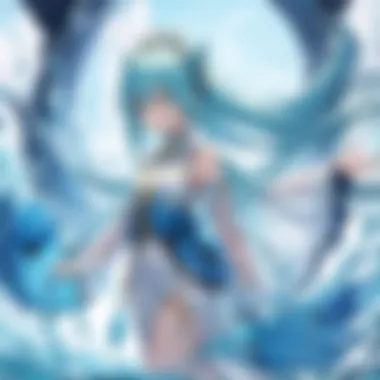Exploring the Depths of 'That Time I Got Reincarnated as a Slime'


Intro
In recent years, the manga That Time I Got Reincarnated as a Slime has carved out a niche in the vast landscape of fantasy narratives. Its unique premise and character dynamics provide a refreshing take on reincarnation tropes often seen in both manga and anime. The series expertly intertwines humor with deeper themes, creating a rich tapestry that resonates with various audiences. This analysis seeks to explore the pivotal elements of the series, examining its plot progression, character arcs, and the cultural context it reflects, ultimately offering insight into its broad appeal today.
Series Overview
Synopsis and Premise
That Time I Got Reincarnated as a Slime follows the story of Satoru Mikami, an ordinary salaryman who meets an untimely demise. However, fate leads him to a fantastical world, where he is reincarnated as a slime creature. Unlike typical reincarnations where characters become powerful warriors or magicians, Satoru embarks on a journey using his new form's unique abilities. He gains the power to absorb other creatures and acquire their skills. This premise sets the stage for an epic adventure filled with challenges and encounters, as Satoru strives to forge a world where different species can coexist peacefully.
Notable Characters
The series is rich in diverse characters that enhance the narrative. Some key figures include:
- Rimuru Tempest: The reincarnated slime who serves as the main character. His goal is to build a prosperous society where all races can thrive together.
- Shuna: A skilled warrior and one of Rimuru's close allies, showcasing loyalty and combat prowess.
- Benimaru: A powerful ogre who becomes a loyal subordinate of Rimuru, embodying strength and leadership.
- Shion: A well-meaning but comically inept guardian, responsible for providing comic relief within the narrative.
These characters contribute depth to the story, showcasing their personal growth alongside Rimuru's journey.
Themes and Motifs
Major Themes Explored
The narrative delves into several critical themes that resonate throughout the manga:
- Community and Acceptance: Rimuru's mission emphasizes the importance of building a cohesive community where diversity thrives.
- Power and Responsibility: The series questions what it means to hold power, emphasizing the moral obligations that come with it.
- Identity and Transformation: Characters often confront their identities, exploring themes of self-discovery and personal growth.
Symbolism in Storytelling
The slime itself serves as a powerful symbol within the series. It represents adaptability and resilience, able to absorb skills and evolve. This element underscores the theme of transformation, as characters reinvent themselves in this new world.
"Adaptability is key in building a world of harmony, something that Rimuru embodies in his role as a leader."
Artistic Style and Animation
Visual Aesthetics and Design
The art style of That Time I Got Reincarnated as a Slime is characterized by vibrant colors and distinct character designs. The attention to detail in the creature designs enhances the fantasy elements. Each character reflects their personality through their visual traits, allowing readers to connect on a deeper level.
Animation Techniques and Trends
The manga's adaptation into anime showcases a blend of traditional animation with modern Digital techniques. Fluid action sequences coupled with comedic moments elevate viewers' experience, making the adaptation appealing. The careful balance between these elements contributes to the overall narrative delivery, drawing in both manga enthusiasts and casual viewers.
Overall, the series provides a blend of engaging storytelling, compelling characters, and a unique perspective on fantasy. As we move forward in this analysis, we will explore specific plot arcs and their impact more deeply.
Intro to 'That Time Got Reincarnated as a Slime'
The advent of 'That Time I Got Reincarnated as a Slime' in the manga world has changed certain perspectives on the fantasy genre. In this section, we will explore the significance of the series, which has attracted a diverse fan base. Analyzing its myriad facets reveals why the series has successfully drawn both critical and popular acclaim. This analysis will serve as a foundation for subsequent discussions about plot, characters, and themes.
This manga's approach to reincarnation and world-building offers a fresh perspective on both established tropes and modern narratives. It serves as an initial entry point for those new to the genre, while also providing depth for seasoned enthusiasts. The balance between humor and drama is accessible yet sophisticated.
Overview of the Series


'That Time I Got Reincarnated as a Slime' follows the tale of Satoru Mikami, a typical salaryman who finds himself unexpectedly reincarnated in a fantasy realm as a slime. This premise alone strays from conventional hero tropes often seen in manga. The series incorporates various fantasy elements, including monsters and magic, while embedding a unique layer of humor. This combination has contributed to its broad appeal. Readers often appreciate the balance of light-hearted elements and deeper, more intricate plot developments.
The manga, written by Fuse, offers a compelling narrative structure. It showcases an evolving world filled with rich lore and multifaceted characters. Each chapter builds upon the foundation laid in previous arcs, giving readers a satisfying sense of progression. The adaptation into an anime series further heightened interest, attracting an even larger audience and leading them to the original manga.
The Concept of Reincarnation in Manga
Reincarnation as a theme has resonated within manga for years, serving as a vehicle for character development and exploration of new worlds. In 'That Time I Got Reincarnated as a Slime', this theme is central to the plot. It allows for a unique exploration of identity and existence. Through Satoru's transformation into Rimuru, the narrative questions the nature of reality and self.
Manga often utilizes this theme to grant protagonists abilities or insights unavailable to them in their previous lives. In this case, Rimuru stands out due to his unique powers, which include absorbing abilities from defeated enemies. This mechanism opens up avenues for world-building and dynamic storytelling.
The series offers readers a lens through which they can reflect on their own lives, ambitions, and desires. Such reflections contribute to its emotional resonance and underlines why the concept of reincarnation remains a popular narrative technique in contemporary manga. It is an effective method for both escapism and meaningful storytelling.
Plot Summary and Structure
The plot summary and structure of a narrative serve critical roles in understanding its dynamics. In That Time I Got Reincarnated as a Slime, the story unfolds through a carefully crafted sequence that provides both excitement and insight into its characters and themes. This section examines how these elements contribute to the overall impact of the series.
A well-defined plot structure helps to maintain reader engagement. It allows the audience to follow the character's journey and understand the transformations that occur. In this manga, the progression of events, from initial setup to major climactic scenes, is pivotal in not only advancing the plot but also highlighting the themes of growth, community, and identity.
Initial Setup and Inciting Incident
The initial setup creates the necessary backdrop for the story. It introduces the protagonist, Satoru Mikami, a middle-aged man who leads an ordinary life in Japan. His abrupt reincarnation as Rimuru Tempest, a slime in a fantastical world, serves as the inciting incident. This radical shift changes everything for the character.
Rimuru's early tasks, such as forming alliances and gaining powers, are significant. These tasks present the challenges and opportunities that will be central to the narrative. The initial setup not only places our character in a new environment, but it also sets the tone for the encounters that shape his identity throughout the series.
Key Arcs in the Story
That Time I Got Reincarnated as a Slime features several key arcs that highlight distinct developments in the plot. Each arc serves to deepen the themes and add layers to the characters. Some notable arcs include:
- The Formation of the Jura Tempest Federation: Here, Rimuru encounters various races, indicating the start of building a diverse community.
- The Conflict with the Demon Lord: This arc introduces serious threats, testing Rimuru's resolve and leadership skills.
- The Ongoing War: A culmination of prior events that showcases power dynamics and alliances. Each arc not only drives the plot forward but also serves to explore the themes of friendship, governance, and self-discovery.
Climactic Events and Resolutions
The climactic moments in the series are crucial for the resolution of conflicts and the growth of characters. They often represent the culmination of tensions that have been building throughout the story. For instance, Rimuru’s fierce confrontation with key antagonists resolves many underlying conflicts. It brings to light his values and the essence of his journey.
The resolutions following these climactic events enable a reflection on the overarching themes of the series. They often tie back to important lessons about leadership, collaboration, and understanding one's identity.
Character Analysis
Character analysis is a critical component in understanding the depth and complexity of narratives, particularly in the context of a series such as 'That Time I Got Reincarnated as a Slime'. This manga employs a rich array of characters, each contributing to the overall plot and evolving themes. Analyzing these characters allows readers to appreciate their motivations, transformations, and roles within the story. When examining characters in detail, one can uncover the underlying messages the creator wishes to convey. This understanding enhances one’s engagement with the narrative, fostering a deeper connection with the material.
Rimuru Tempest: The Protagonist's Journey
Rimuru Tempest stands at the forefront of this story, offering a unique perspective as both a former human and a being of slime. His journey begins with a common trope of reincarnation but quickly diverges into an exploration of ethics and leadership. Rimuru’s pragmatic approach to problem-solving resonates with audiences, emphasizing adaptability and resilience.
Throughout his evolution, Rimuru grapples with the dichotomy of power and responsibility. His transformation into a leader showcases his commitment to building a community rather than merely amassing strength. This nuanced portrayal highlights the profound effect of choices and the moral implications that accompany them.
Supporting Characters and Their Roles
Supporting characters in 'That Time I Got Reincarnated as a Slime' are not mere accessories but pivotal to the story's development. Each character brings their own background, motives, and conflicts, enriching the narrative fabric. For instance, characters like Benimaru and Shuna serve not only as allies but also as representations of loyalty and diverse perspectives within the community.
These characters often challenge Rimuru, presenting conflicting worldviews that provoke growth and introspection. Their interactions enhance the thematic depth, particularly concerning community dynamics and trust. By examining their roles, one can gain insight into how relationships shape individual agency and collective goals in a fantastical setting.
Character Development and Growth


Character development and growth are central themes in the manga. As Rimuru navigates challenges, he encounters various situations that test his ideals and leadership. His growth is not linear; instead, it reflects realistic struggles that individuals face when their beliefs are put to the test.
Supporting characters also undergo notable transformations. Characters like Diablo and Shuna evolve from individuals bound by their pasts to integral parts of Rimuru's vision. Observing their character arcs reveals how experiences and interactions can reshape identities and establish a sense of purpose.
In summary, the character analysis in 'That Time I Got Reincarnated as a Slime' illustrates essential life lessons about community, power, and personal growth. This detailed examination fosters a richer understanding of the manga's narrative and its connection to broader societal themes.
Themes and Motifs
The exploration of themes and motifs in 'That Time I Got Reincarnated as a Slime' provides depth to its narrative. These themes not only drive the plot but also reflect on more poignant aspects of human existence. Dissecting the themes presents an understanding of friendships, power structures, and the journey of self-awareness that resonates with readers. This analysis focusses on how these elements contribute to the series’ popularity and cultural relevance.
Friendship and Community Building
At the core of 'That Time I Got Reincarnated as a Slime' is the theme of friendship. The protagonist, Rimuru Tempest, fosters relationships with various beings in the new world. This theme emphasizes the value of camaraderie and cooperation. Rimuru's journey illustrates how alliances can lead to positive outcome for communities. Important friendships, like those with Shion, Shuna, and others, reveal how interdependence can enhance not just individual strength but also group cohesion.
The idea of community building is pivotal as Rimuru transitions from a solitary slime to a leader of a diverse population. His actions and decisions show a deliberate effort to create a safe space for all beings, regardless of their background. This motif of inclusivity is vital, drawing parallels to contemporary societal challenges concerning diversity and acceptance. Through these relationships, the manga reflects an optimistic view of community as a unifying force.
Power Dynamics and Governance
The narrative delves into intricate power dynamics. Rimuru’s rise to leadership raises questions about authority, responsibility, and justice. He encounters various factions and must navigate through complex political landscapes. The depiction of governance within the series prompts readers to ponder the nature of power and its ethical implications.
Rimuru’s approach to leadership is a unique blend of strength and compassion. His decisions often prioritize the welfare of his allies over sheer dominance, providing a critique of traditional power structures. Such motifs encourage readers to examine their own beliefs about governance and the consequences of political actions. This theme underlines the idea that effective leadership is not merely about control but also about fostering trust and cooperation among constituents.
Identity and Self-Discovery
Identity is another profound theme explored in the manga. Rimuru’s transformation from a human to a slime presents a fresh perspective on self-discovery. His journey illustrates the complexities of understanding oneself in a constantly changing environment. The quest for identity is not just about physical form; it encompasses capabilities, values, and relationships.
Rimuru’s evolution serves as a metaphor for the struggles individuals face in defining themselves. This theme resonates with audiences searching for their own identities amidst societal expectations. The characters within the story also reflect various facets of identity and transformation, enhancing the reader's engagement with their personal journeys.
Art Style and Visual Representation
The art style in 'That Time I Got Reincarnated as a Slime' is crucial to its identity and appeal. Visual representation plays a significant role in connecting the audience with the narrative and characters. The artistic choices enhance the storytelling by creating a unique atmosphere. Moreover, the illustrations contribute to the charm and engagement of the series, making it stand out in a crowded genre.
Illustration Techniques in the Manga
The illustration techniques used in the manga involve a blend of detailed backgrounds and expressive character designs. The use of vibrant colors brings the world to life, making settings feel immersive. Shadows and highlights are used effectively, allowing characters to convey emotions and actions clearly. Additionally, the manga employs panel layouts that guide the reader's eye and pacing, enhancing the overall storytelling experience. Through these techniques, the artists manage to convey complex scenes in a visually accessible manner.
Character Design and Aesthetic Choices
Character design is another essential aspect of the manga's visual appeal. The characters are designed not only to be visually interesting but also to reflect their personalities and roles in the story. For instance, Rimuru Tempest, the protagonist, features round shapes that suggest friendliness and approachability. Supporting characters also exhibit unique designs that embody their traits and background.
In terms of aesthetic, the combination of traditional manga styles with a modern flair contributes to the overall vibrancy of the characters. Clothing designs are detailed and resonate with the fantasy element, while facial expressions are exaggerated, helping to communicate humor and emotion effectively.
Impact of Visual Elements on Storytelling
Visual elements significantly shape storytelling in 'That Time I Got Reincarnated as a Slime'. The art not only conveys action but also deepens the emotional resonance of significant moments. Moments of conflict are depicted through dynamic scenes with high contrasts, while calming sequences utilize softer colors and flowing lines.
Furthermore, the visual representation of various creatures and settings helps to construct a well-rounded fantasy world. Each species has distinctive traits, allowing readers to appreciate the diversity inherent in the narrative.
"The fusion of vibrant colors and detailed designs provides an immersive experience that enhances the story's engagement with audiences."
Ultimately, the art style is instrumental in reinforcing the themes and tones of the manga, marrying visual and narrative elements in a cohesive manner.


Cultural Implications
Cultural implications play a significant role in shaping the narrative and themes of 'That Time I Got Reincarnated as a Slime'. This manga not only entertains but also serves as a reflection of various facets of Japanese society, as well as the broader trends in fantasy storytelling. Understanding these aspects can enhance the appreciation of the series and its relevance in contemporary culture. By examining how cultural elements are woven into the storyline and character arcs, we can ascertain the value it adds to the manga genre.
Reflections of Japanese Society
'That Time I Got Reincarnated as a Slime' presents a contrast to the traditional Japanese societal norms. The narrative highlights themes of community and cooperation, offering a different lens through which readers can view social structures. In a society often marked by individualism and hierarchies, the protagonist, Rimuru Tempest, champions the ideals of unity and mutual support within the fantasy realm.
The emphasis on building a community, as Rimuru gathers various races under his leadership, reflects ideals of harmony that are valued in Japanese culture. Moreover, the way Rimuru deals with conflicts and governance highlights the importance of diplomacy and understanding—qualities admired in modern Japanese society.
Additionally, the manga subtly addresses issues of coexistence among different groups. This mirrors Japan’s own social dynamics, where diverse cultures and ideas converge. While the interactions in the series often involve lighthearted humor, they also provoke thought on essential social themes that resonate with readers, allowing them to relate personally to these character experiences.
The Role of Fantasy in Modern Storytelling
Fantasy is a powerful narrative tool employed in 'That Time I Got Reincarnated as a Slime', allowing for exploration of complex themes in an engaging manner. The genre provides a unique escape from reality, yet, it also facilitates a nuanced commentary on contemporary issues. The fantastical elements serve as an allegory for real-world challenges, inviting audiences to reflect on their societal context.
In this series, reincarnation acts as a vehicle for personal growth and self-discovery. Rimuru's transformation from a human to a slime creates opportunities to rethink identity and purpose. This reframing allows for a deeper examination of societal roles and expectations and how they can be subverted or reshaped.
Moreover, the use of fantasy enables a broader discussion about values such as friendship, cooperation, and governance. These themes are presented in a way that encourages readers to think critically about their own lives and the structures around them. As fantasy expands the boundaries of storytelling, it becomes not only a source of entertainment but also a medium for philosophical inquiry into human nature and society.
"Fantasy narratives can provide critical insights into our world by presenting alternative realities that reflect our truths."
Audience Reception and Impact
The reception of a manga plays a critical role in its continued success and influence within the genre. This section delves into both the critical acclaim and the active fan engagement surrounding 'That Time I Got Reincarnated as a Slime.' Understanding these elements helps in comprehending why this series resonates strongly with its audience and how it contributes to broader anime and manga culture.
Critical Acclaim and Reviews
'That Time I Got Reincarnated as a Slime' has received numerous positive reviews from critics and readers alike. Review platforms such as MyAnimeList and AniList feature high ratings, signifying its popularity. Critics often praise the character development and engaging plot lines, highlighting how the narrative balances humor and action effectively. For example, some point to the unique ability of Rimuru to absorb monsters and learn from them, noting it reflects deeper themes of acceptance and understanding in a fantastical context.
In addition, several reputable manga reviewers emphasize the well-executed world-building. The different nations and their respective cultures are elaborately crafted, allowing readers to immerse themselves in this new realm. The themes of friendship and community resonate throughout the reviews, making it clear that the series strikes a chord with its audience on multiple levels.
Fan comments and reviews on social media platforms like Reddit and Facebook show a lively ongoing discussion about the series. Fans express excitement for new chapters and ongoing developments in Rimuru's journey. This grassroots engagement underlines a devoted fanbase that not only appreciates the narrative but actively participates in the discourse surrounding it.
Fan Community and Engagement
The fan community surrounding 'That Time I Got Reincarnated as a Slime' has grown remarkably. Online forums such as Reddit host dedicated threads where fans share theories about character arcs and future plot developments. Here, readers analyze recent episodes and chapters, revealing an eager audience trying to piece together the intricate storyline.
Additionally, social media platforms amplify this engagement even further. Fans regularly share fan art, cosplay, and memes related to the series, creating a wide range of content that enriches their collective experience. This level of engagement fosters a sense of belonging among fans, encouraging them to interact with both the content and each other.
Another notable aspect is the participation in events like anime conventions. Fans often host panels discussing character analysis and thematic exploration, providing a space for deeper conversations about the series. These interactions not only bolster community ties but also keep the series fresh in public discourse, proving that its impact reaches beyond mere viewership.
Culmination
The conclusion plays a critical role in encapsulating the key insights derived from the exploration of 'That Time I Got Reincarnated as a Slime.' It serves as the ultimate synthesis of the various elements discussed throughout this article. A well-rounded conclusion weaves together themes of character development, cultural implications, and audience reception, providing a cohesive understanding of the entire series.
Summary of Key Insights
Throughout the analysis, we have uncovered various dimensions that contribute to the series' appeal:
- Unique Narration: The story’s perspective from a slime, an unconventional protagonist, challenges traditional hero tropes.
- Character Relationships: Rimuru Tempest’s interactions foster a sense of community, echoing real-life social dynamics.
- Thematic Relevance: Themes of identity and self-discovery resonate deeply with audiences, engaging them both intellectually and emotionally.
- Cultural Reflections: The series incorporates elements reflective of contemporary Japanese society, bridging fantasy with real-world issues.
- Visual Storytelling: The art style complements the narrative, enhancing viewers' engagement through striking illustrations.
By synthesizing these insights, it becomes evident how the series manages to captivate a diverse audience base and maintain relevance in the manga landscape.
Future of the Series in Manga and Anime
Looking ahead, the future of 'That Time I Got Reincarnated as a Slime' appears promising. Both manga and anime have expanded the narrative universes, giving rise to potential new arcs and character backstories that can further develop. Factors influencing the future include:
- Ongoing Manga Releases: Continuous narrative development promises opportunities for deeper storylines and character growth.
- Adaptations and Spin-offs: The success of the anime adaption creates avenues for additional content, enticing new fans to explore the source material.
- Global Audience Growth: Increased interest from international audiences may lead to more localized versions and wider distribution.



